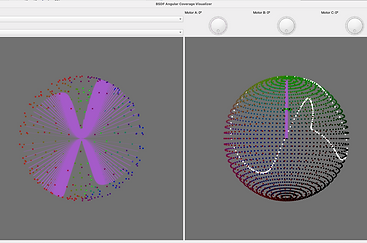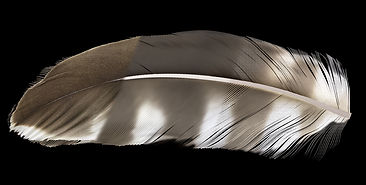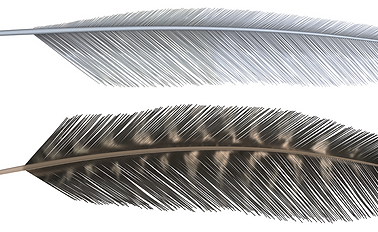ACADEMIC RESEARCH AND PUBLICATIONS
during Graduate and Undergraduate Studies

Doctoral Candidate in Computer Science
Visual Computing Division, Digital Production Arts
Clemson University | School of Computing
VISUAL COMPUTING RESEARCH & DEVELOPMENT
-
PhD Dissertation (SVBRDF Acquisition)
-
Film, VFX, Real-Time Studio Internships
-
MS Thesis (Procedural Feather Geometry)
-
Further Research
SPATIALLY VARYING MATERIAL (SVBRDF) CAPTURE & VARIABLE ILLUMINATION SPHERE (VARIS) DEVELOPMENT

Variable Illumination Sphere (VarIS)
(Photograph by Ashley Jones for the Clemson World feature article on VarIS)
VarIS is a multi-purpose system for acquiring and processing real-world geometric and appearance data for computer-graphics research and production. Its key applications among many are (1) human-face capture, (2) model scanning, and (3) spatially varying material acquisition. It is a system of hardware and software for spherical illumination and imaging that has been custom designed and developed by the Countenance Lab at Clemson University. It has been inspired by Light Stages and goniophotometers, but costs less through use of primarily off-the-shelf components, and additionally extends capabilities beyond these devices.

Spatially Varying Material Capture
My PhD dissertation focuses on acquiring Spatially Varying Bidirectional Reflectance Distribution Function (SVBRDF) data especially for feathers and their varied real-world appearances. This long-term project involves adapting state-of-the-art material-acquisition techniques for an image-based system and preserving spatially varying features from HDR images in an efficient manner.
Poster: Toward Efficient Capture of Spatially Varying Material Properties
Awarded 2nd place ACM Research Competition (Graduate), SIGGRAPH 2023


Visualizing VarIS in Maya and Houdini
To aid in the development of VarIS, I leveraged scripting with the DCCs Autodesk Maya and SideFX Houdini to create animated virtual scenes to aid in choosing rotations of the 3-arm stage design and in selecting VarIS's 364 lights to form illumination patterns.

Camera Control GUI
This graphical user interface is a critical tool in calibrating the cameras, lights, and sample alignment for material capture within VarIS. It features automatic alignment based on visual markers and peak reflectance as well as offers fine tuning of stage rotations and control over camera settings. It is built with Python, PyQt, gphoto2, and OpenCV.

Photometric and Photogrammetric Facial Capture
I set up the initial facial-capture pipeline with VarIS leveraging numerous (16+) cameras, polarization, and gradient illumination to acquire normal, diffuse, and specular images of a face. These images can be used in photogrammetry workflows to estimate the geometry of the face and produce detailed texture maps.

GUI for Visualizing Directional Coverage
Choosing lighting, viewing, and orientation directions is crucial for representing how a surface material interacts with light. This GUI is for visualizing the directions involved with light-material interaction particularly in the context of choosing directions specific to VarIS's capabilities.
INDUSTRY INTERNSHIPS AT ANIMATION, VISUAL-EFFECTS, AND REAL-TIME STUDIOS

RenderMan Software-Development Internship at Pixar Animation Studios
I joined Pixar's RenderMan Group in Seattle, WA for 3 months where I implemented the Disney Principled BSDF for the RenderMan path-traced renderer, mentored by Per Christensen. I additionally researched hair shading models, assisted with the RenderMan XPU effort, and helped with the annual RenderMan Art & Science Fair co-located with ACM-SIGGRAPH. The associated image consists of garlic bulbs from the kitchen RenderMan Art Challenge with the Disney BSDF RenderMan material applied.

Software-Engineering Internship at Weta Digital
I completed a 3-month internship at the visual-effects studio Weta Digital, joining the "Fur and Feathers" team to help start a new, in-house procedural-feather tool. My work focused on developing a biologically accurate model for feathers, capturing parameters that change based on the type of feather and further alterations. I had done both research and development for this project, gathering and understanding information on the biology and physics of feathers along with developing a C++ library and external software plug-ins.

Rendering-Programming Internship at Epic Games
Through cross-departmental communication and research of prior and state-of-the-art related work while working from home, I implemented a UV-less, volumetric data structure as a part of the rendering module of Unreal Engine 5.
FEATHERS IN COMPUTER GRAPHICS AND VISION

Procedurally Shading Feather Microstructures
I developed a new technique that takes into account the substructures of feathers during shading calculations to produce a more accurate far-field appearance.
Paper: Microstructure-based Appearance Rendering for Feathers Re
Poster: Procedural Shading for Rendering the Appearance of Feathers
Awarded 3rd place ACM Research Competition (Graduate), SIGGRAPH 2021

Feather Image Analysis
Little statistics are gathered on the variation of microstructural arrangement of feathers such as the density of barbs branching from the central shaft of a feather. Leveraging the Fast Fourier Transform on images from The Feather Atlas, I estimate the density of barbs per length of a feather.
Workshop Paper: Computer-Aided Visual Analysis of Feathers

Procedurally Generating Biologically Driven Bird and Non-Avian Dinosaur Feathers
This thesis focuses particularly on bird and other dinosaur feathers and their structure. More specifically, it addresses the problem of procedurally generating biologically driven geometry for modeling feathers in computer graphics. As opposed to previously published methods for generated feather geometry, data is derived from a myriad of real-world specimens of feathers and used in creating graphical models of feathers.
COUNTENANCE LAB
The Countenance Lab is a research group led by Dr. Eric Patterson at Clemson University in the Visual Computing division of the School of Computing. The lab focuses on 2D and 3D facial analysis, using techniques from computer vision, computer graphics, and machine learning. Ongoing projects include capture and study of human faces, material capture, and automated age progression.

Countenance Tool (Software)
The Countenance Tool is a user-friendly software interface for both 2D and 3D work on objects, particularly human faces. I have written this code and continue to add features as the Lab conducts new studies. The software is built in Python using PyQt5 bindings of the GUI library Qt5, through which GLSL-shader-based OpenGL 4.x is accessed for 3D rendering. The video captures the Tool performing part of the process used in re-topology project.

Re-topology of Human Faces
This project is focused on automating the re-topology of dense scans of human faces. Using a quadrangulated template mesh that follows the musculature of the human face, a series of Facial Action Coding System (FACS) scans of a subject are reduced to an edge layout following the template mesh using interactive 2D landmarking that triggers changes in a resulting 3D mesh.
This is an ongoing study. The merit of the idea is showcased as an ACM-SIGGRAPH Symposium on Interactive 3D Graphics and Games (i3D) 2018 poster.
Focusing on the llandmark-based approach, the re-topology study is discussed in an accepted paper at the International Conference on Computer Vision and Graphics (ICCVG) 2018 to be published in Springer's Lecture Notes in Computer Science journal.

Quad-Mesh AAMs
This project is on incorporating the use of a quadrangulated mesh rather than Delaunay Triangulation in Active Appearance Models (AAMs). The goal of this study is to show that a 2D quad-mesh that follows the musculature of the face can lead to image synthesis results that are better than those from a 2D triangular mesh created from landmarks.